Infinite-order square tiling
 From Wikipedia the free encyclopedia
From Wikipedia the free encyclopedia
Top View
This article includes a list of references, related reading, or external links, but its sources remain unclear because it lacks inline citations. (March 2014) |
| Infinite-order square tiling | |
|---|---|
 Poincaré disk model of the hyperbolic plane | |
| Type | Hyperbolic regular tiling |
| Vertex configuration | 4 |
| Schläfli symbol | {4,∞} |
| Wythoff symbol | ∞ | 4 2 |
| Coxeter diagram | |
| Symmetry group | [∞,4], (*∞42) |
| Dual | Order-4 apeirogonal tiling |
| Properties | Vertex-transitive, edge-transitive, face-transitive |
In geometry, the infinite-order square tiling is a regular tiling of the hyperbolic plane. It has Schläfli symbol of {4,∞}. All vertices are ideal, located at "infinity", seen on the boundary of the Poincaré hyperbolic disk projection.
Uniform colorings
[edit]There is a half symmetry form, ![]()
![]()
![]()
![]() , seen with alternating colors:
, seen with alternating colors:
Symmetry
[edit]This tiling represents the mirror lines of *∞∞∞∞ symmetry. The dual to this tiling defines the fundamental domains of (*2) orbifold symmetry.
This tiling is topologically related as a part of sequence of regular polyhedra and tilings with vertex figure (4).
| *n42 symmetry mutation of regular tilings: {4,n} | |||||||||||
|---|---|---|---|---|---|---|---|---|---|---|---|
| Spherical | Euclidean | Compact hyperbolic | Paracompact | ||||||||
 {4,3} |  {4,4} |  {4,5} |  {4,6} |  {4,7} |  {4,8}... |  {4,∞} | |||||
| Paracompact uniform tilings in [∞,4] family | |||||||
|---|---|---|---|---|---|---|---|
 |  | 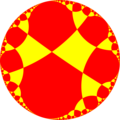 |  |  | 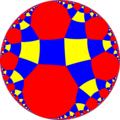 |  | |
| {∞,4} | t{∞,4} | r{∞,4} | 2t{∞,4}=t{4,∞} | 2r{∞,4}={4,∞} | rr{∞,4} | tr{∞,4} | |
| Dual figures | |||||||
 | 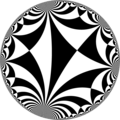 |  | 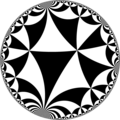 |  |  |  | |
| V∞ | V4.∞.∞ | V(4.∞) | V8.8.∞ | V4 | V4.∞ | V4.8.∞ | |
| Alternations | |||||||
| [1,∞,4] (*44∞) | [∞,4] (∞*2) | [∞,1,4] (*2∞2∞) | [∞,4] (4*∞) | [∞,4,1] (*∞∞2) | [(∞,4,2)] (2*2∞) | [∞,4] (∞42) | |
= | = | ||||||
| h{∞,4} | s{∞,4} | hr{∞,4} | s{4,∞} | h{4,∞} | hrr{∞,4} | s{∞,4} | |
 |  | 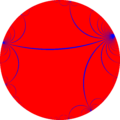 |  | ||||
| Alternation duals | |||||||
 |  | ||||||
| V(∞.4) | V3.(3.∞) | V(4.∞.4) | V3.∞.(3.4) | V∞ | V∞.4 | V3.3.4.3.∞ | |
See also
[edit]References
[edit]- John H. Conway; Heidi Burgiel; Chaim Goodman-Strauss (2008). "Chapter 19, The Hyperbolic Archimedean Tessellations". The Symmetries of Things. ISBN 978-1-56881-220-5.
- H. S. M. Coxeter (1999). "Chapter 10: Regular honeycombs in hyperbolic space". The Beauty of Geometry: Twelve Essays. Dover Publications. ISBN 0-486-40919-8. LCCN 99035678.



